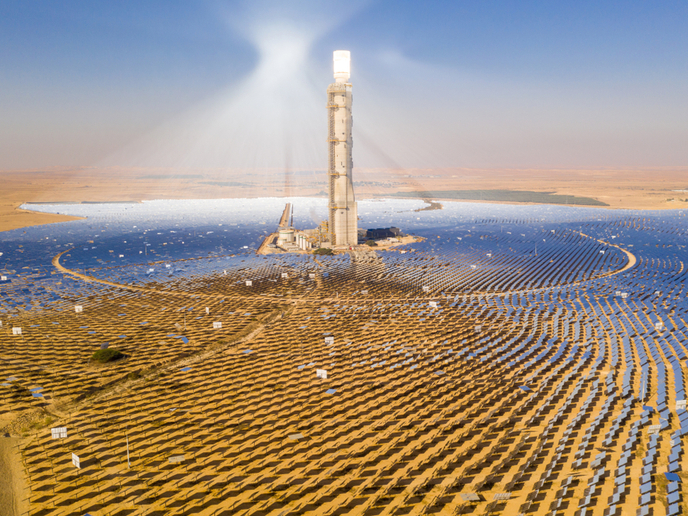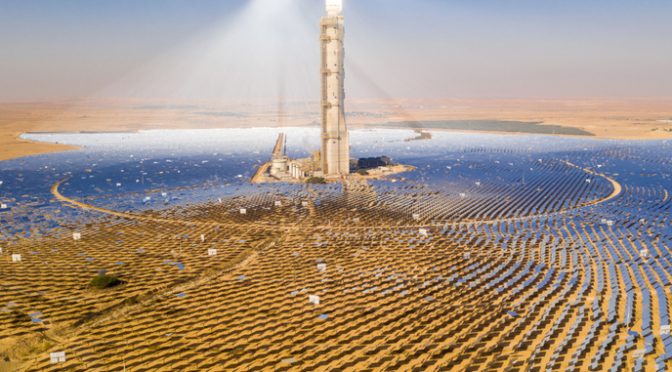The Sun could be the world’s largest source of electricity by 2050, ahead of fossil fuels, wind energy, hydro and nuclear.
Specifically, solar thermal electricity from concentrated solar power (CSP) systems could provide over 10 % of the world’s electricity by mid-century and prevent the emission of billions of tonnes of CO2 per year.
This CORDIS Results Pack showcases some of the cutting-edge projects in research and innovation that boost development of Concentrating Solar Power and encourage uptake of solar thermal energy.

© StockStudio Aerials, Shutterstock
Concentrated solar technology systems use mirrors or lenses with tracking systems to focus a large area of sunlight onto a small area. In theory, it is a very simple idea and certainly not a new one. Legend has it that Archimedes had set fire to Roman vessels attacking his home city with a giant mirror focusing the sun’s rays. Concentrating technologies exist in four optical types, namely parabolic trough, dish, linear Fresnel reflector and solar power tower. Solar thermal power plants generate electricity indirectly: the concentrated light is used to heat a fluid. The steam produced from the heated fluid powers a generator that produces electricity. The solar concentrators used in Concentrating Solar Power systems can also be used to provide industrial process heating or cooling. Often, excess thermal energy (heat) can be stored in tanks or materials and used to generate electricity on demand.
European Union support for Concentrated Solar Power
Horizon 2020, the EU’s funding programme for research and innovation in the period 2014-2020, has allocated almost EUR 6 billion to non-nuclear energy research through its societal challenge ‘Secure, Clean, Efficient Energy’. More specifically, the energy challenge supports the transition to a reliable, sustainable and competitive energy system. The projects in this Results Pack have successfully risen to meet this energy challenge, focusing on technologies that help reduce costs and increase performance of solar thermal plants. Their objectives are in line with the European Strategic Energy Technology Plan (SET Plan), specifically the Implementation Plan for CSP, which aims to maintain (or regain in some cases) the EU’s global leadership on low-carbon technologies.

Nine shining research and innovation projects
This CORDIS Pack covers a mix of research, demonstration and market uptake actions aimed at fostering Concentrated Solar Power development in Europe for electricity generation and industrial process heating or cooling. All of them are supported by the European Union’s framework programme Horizon 2020. CAPTure focused on a high-efficiency power plant concept that combines several towers, heliostats and, importantly, combined gas and steam turbine cycles. This new configuration maximises overall efficiency, reliability and dispatchable operation of CSP plants.
Another action, HyCool, demonstrated a cost-efficient and easy-to-install linear Fresnel system that can be adapted to supply industry’s cooling and heating needs. Then we have MOSAIC, which used fixed spherical concentrators that eliminate the need for tracking systems to focus light. Unlike their mobile counterparts, they reflect the sun’s light onto a solar receiver, without ever moving. MUSTEC proposed concrete solutions to overcome the market barriers that hinder the deployment of CSP cooperation projects. Meanwhile, NEXT-CSP used fluidised crystal particles as a heat transfer and storage medium, which are an alternative to molten salts. In a similar vein, PEGASUS demonstrated an innovative concept combining sulfur and a new rotating cylindrical receiver that can store more solar energy for longer periods of time. ORC-PLUS demonstrated an innovative thermal energy storage system optimised for midsized CSP plants. SOLPART developed a technology that could provide heat for a wide variety of industrial processes, including the processing of lime and other non-metallic minerals. Finally, WASCOP proposed a holistic solution helping reduce water use and facilitate water management in Concentrated Solar Power plants.


